If you’re planning to visit Paris, the Louvre Museum is an absolute essential stop. Having explored it many times myself, I can confidently say that no trip to the city is complete without it. This museum isn’t just the world’s largest – it’s a world of its own, packed with over 35,000 works of art that span centuries and civilizations.
The Louvre’s collection is nothing short of legendary. It’s home to iconic masterpieces like the Mona Lisa and Venus de Milo, but there’s so much more to discover. Whether you’re into ancient Egyptian artifacts, Renaissance paintings, or 19th-century sculptures, the Louvre offers an unparalleled range of art that you won’t find in one place anywhere else. It’s one of those rare places where you can wander through history and literally feel the past around you.
I also can’t overlook the sheer beauty of the museum itself. The building is an architectural marvel, blending classic design with modern touches like the glass pyramid entrance. It’s as much about the experience of walking through the Louvre’s halls and galleries as it is about the art you’re seeing.
Trust me, the Louvre isn’t just for art lovers – it’s for anyone curious about history, culture, and the incredible creativity that has shaped our world. If you go in with an open mind and a few hours to spare, you’ll come out having experienced one of the most enriching museums on the planet.
Basic Information about Louvre Museum
Opening Hours
- Regular Hours: Monday, Thursday, Saturday, and Sunday: 9:00 AM to 6:00 PM
- Extended Hours: Wednesday and Friday: 9:00 AM to 9:00 PM
- Closed Days: Tuesdays, January 1, May 1, and December 25.
- Last entry: 1 hour before closing
- Clearing of rooms: 30 minutes before closing
Ticket Information
Ticket Options
- General Admission:
- Price: €22
- What’s Included: Grants access to the permanent collections and temporary exhibitions at the museum.
- Free Admission:
- Eligibility:
- Visitors under 18 years of age (regardless of nationality).
- Residents of the European Economic Area (EEA) under 26 years old.
- Certain other visitors, such as teachers, journalists, and those with disabilities.
- Special Circumstances: Free entry on the first Saturday of every month (from 6 PM to 9:45 PM), and on Bastille Day (14th July).
- Eligibility:
How to Purchase Tickets
- Online:
- The most convenient way to purchase tickets is through the Louvre’s official online ticketing system. You can choose a specific time slot for entry and purchase tickets in advance.
- Benefits of Online Purchase:
- Skip the lines at the entrance.
- Guarantee entry during your preferred time.
- You’ll receive a digital ticket that can be shown on your smartphone.
- On-Site Purchase:
- Tickets are also available for purchase directly at the museum’s ticket counters. However, you may face longer wait times, especially during peak hours or busy seasons.
- You’ll still need to choose a time slot for your visit when buying tickets on-site.
Ticket Details
- Nominative Tickets:
- All tickets are nominative (linked to the buyer), and must be printed or downloaded before your visit. You cannot use the confirmation email alone as a ticket.
- Once purchased, tickets are non-transferable.
- Time Slot Reservation:
- Online tickets include a mandatory time slot reservation. This system is in place to manage the flow of visitors and reduce overcrowding, especially in popular galleries like the Mona Lisa and the Venus de Milo.
- After entry, you are free to stay in the museum until closing time, but re-entry is not allowed.
How to Get to Louvre Museum


The Louvre Museum is located in the heart of Paris, France, in the 1st arrondissement (district). The specific address is Louvre Museum, Rue de Rivoli, 75001 Paris, France.
Two Main Entrances of Louvre Museum
Pyramid Entrance (Main Entrance):
- Location: In the Cour Napoléon, right in front of the iconic glass pyramid.
- Description: This is the most famous and most frequently used entrance. Visitors enter through the large glass pyramid, designed by architect I. M. Pei. It leads to the Hall Napoléon and provides access to the Denon, Sully, and Richelieu wings.
- Opening Hours: It is open during regular museum hours.
Carrousel du Louvre Entrance:
- Location: In the underground shopping mall, the Carrousel du Louvre, which is located beneath the museum’s courtyard, near the Pyramid Entrance.
- Description: This entrance is often used by visitors who arrive via public transport (such as the Palais Royal – Musée du Louvre metro station). It connects directly to the Hall Napoléon area.
- Opening Hours: This entrance is open during museum hours, typically from 9:00 AM to 6:00 PM.
1. By Paris Metro (Subway)
- Palais Royal – Musée du Louvre Station (Lines 1 and 7):
- This is the main metro station for accessing the Louvre.
- Line 1 (Yellow Line): Connects the Louvre to major areas such as La Défense, Châtelet, and Bastille.
- Line 7 (Pink Line): Connects the Louvre to neighborhoods like Opéra, Château-Landon, and Pyramides.
- Once you exit the station, follow the signs to the Louvre Pyramid (main entrance). It is only a short walk from the metro.
- Louvre – Rivoli Station (Line 1):
- Another nearby option for accessing the Louvre is the Louvre – Rivoli station, also on Line 1.
- It’s located at the end of Rue de Rivoli, and it’s a short walk to the museum’s main entrance.
- Travel Tip: The Paris Metro runs frequently, and using a multi-day travel pass like the Navigo card or Paris Visite pass can save you money if you plan to use the metro often.
2. By RER (Regional Express Network)
While the RER trains are mostly used to travel to and from the suburbs, there is one RER line that offers a convenient route into the heart of Paris, with a stop near the Louvre.
- RER Line C:
- Station: Musée d’Orsay
- While this stop is a bit farther from the Louvre compared to the metro stations, you can easily transfer to the Metro Line 12 or Line 1 at the Concorde station to reach the museum.
- Alternatively, you can take a 10-minute walk from Musée d’Orsay along the river to reach the Louvre.
3. By Bus
There are also several bus lines that pass close to the Louvre, offering a scenic and direct route.
- Lines 21, 27, 39, 48, 67, and 95:
- Stop: Pyramides (for Rue de Rivoli), or Palais Royal – Musée du Louvre (for the main entrance).
- The buses can be an excellent option if you’re carrying luggage or prefer to see the city while traveling.
- Travel Tip: Consider using the Paris Bus app to check live schedules and routes, especially since traffic in central Paris can sometimes cause delays.
4. By Taxi or Ride-Sharing Services (Uber, Bolt)
- Taxi Stand Locations:
- The Louvre has taxi stands located near the Louvre Pyramid and Carrousel du Louvre entrance. You can also find taxis at nearby hotels.
- Ride-Sharing (Uber, Bolt, etc.):
- Uber and other ride-sharing services are widely available in Paris, and they can drop you off directly at the museum’s entrances.
- Cost: The price of a taxi or ride-share varies, but expect to pay around €15 to €25 depending on your starting point in Paris.
5. By Bicycle or Electric Scooter
Paris has become an increasingly bike-friendly city, with dedicated bike lanes and bike-sharing services like Velib’ available throughout the city. The Louvre Museum is also accessible by bicycle.
- Bike Stations: There are several Velib’ bike stations near the Louvre, including one at the Rue de Rivoli, just outside the museum.
- Electric Scooters: You can also rent electric scooters from various operators around the city, such as Lime, Dott, or Bolt. Simply use their apps to find a nearby scooter and ride directly to the museum.
- Travel Tip: Be aware that bicycle and scooter parking near the museum is limited, and you may have to walk a little from your drop-off point.
6. On Foot
For those staying nearby or wanting to explore Paris on foot, walking to the Louvre is a great option. The museum is located in central Paris, and it is within walking distance from many major landmarks such as:
- Notre-Dame Cathedral (20 minutes walk)
- Champs-Élysées (25 minutes walk)
- Musée d’Orsay (10 minutes walk)
A walk to the Louvre allows you to explore the beautiful neighborhoods of Paris, including the historic Palais Royal, Tuileries Gardens, and Rue de Rivoli.
7. From Charles de Gaulle Airport (CDG)
If you’re arriving at Charles de Gaulle Airport (CDG), you have a few options to get to the Louvre:
- By RER B:
- Take the RER B train from the airport to Châtelet-Les Halles station, where you can transfer to Line 1 of the Metro. Then, head to Palais Royal – Musée du Louvre station.
- Travel time: Around 45 minutes.
- By Airport Shuttle or Taxi:
- A direct shuttle service is available from CDG to central Paris, but it can be more time-consuming.
- A taxi from the airport to the Louvre can cost around €50 to €60.
8. From Orly Airport (ORY)
- By Orlyval + RER B:
- Take the Orlyval light rail from Orly to Antony station, then transfer to RER B to reach central Paris. From there, take Metro Line 1 to Palais Royal – Musée du Louvre.
- Travel time: Approximately 40-50 minutes.
- By Taxi:
- A taxi ride to the Louvre from Orly Airport will cost approximately €35 to €45, depending on traffic.
Guided Experiences to Enhance Your Visit
1. Guided Tours (In-Person)
The Louvre offers a variety of in-person guided tours with professional guides who will provide insightful commentary on the museum’s collections. These tours are available in multiple languages, including English, French, Spanish, Italian, and others.
- Private Guided Tours:
- Details: Tailored to your preferences, private tours allow for a personalized experience. Whether you’re interested in a deep dive into certain collections, specific artists, or general highlights, these tours can be customized.
- Duration: Typically 1.5 to 2 hours.
- Price: Rates vary depending on the group size and language, but generally, private tours start from around €90 for a group of up to 6 people.
- Booking: Advanced booking is essential, especially during peak seasons, and can be done via the Louvre’s official website or through a third-party service.
- Group Tours:
- Details: Group tours are available for 7 or more people. These tours can be themed around specific galleries, such as Egyptian Antiquities, Renaissance Paintings, or even a comprehensive museum tour.
- Duration: 1.5 to 2 hours.
- Price: Prices are generally more affordable per person, with group tours starting at around €20 per person, though costs can vary depending on the tour specifics.
- Booking: Must be reserved in advance via the museum or third-party agencies.
2. Audio Guides
If you prefer to explore the museum at your own pace, the Louvre’s audio guide system is a great choice. The audio guide offers commentary on key works of art and provides a deeper understanding of their historical and artistic significance.
- What’s Included:
- The audio guide includes commentary on approximately 700 works across the museum’s collections.
- The commentary is available in several languages, including English, French, Spanish, Italian, German, Japanese, and more.
- How to Rent:
- Audio guides can be rented at the museum upon arrival.
- You can also pre-book an audio guide via the official Louvre Museum website to avoid long queues.
- Cost:
- Rental typically costs around €5 to €7 for an audio guide.
3. Louvre App & Digital Guides
For a more tech-savvy experience, the Louvre Museum offers a free official app that provides self-guided tours, exhibition information, and other useful features. The app can be downloaded on smartphones and is a great option for those who enjoy using technology to enhance their visit.
- Features:
- Interactive Map: Navigate through the museum easily with a built-in map.
- Exhibition Information: View descriptions, background, and historical context of the works on display.
- Themed Tours: Take advantage of different thematic tours, such as “Highlights of the Louvre,” “Masterpieces of the Renaissance,” or “Egyptian Antiquities.”
- Multilingual Support: Available in English, French, Spanish, German, Italian, Chinese, Japanese, and other languages.
- Cost: Free to download and use.
4. Audio and Mobile-Based Guided Tours (Third-Party Services)
Several third-party companies offer guided tours via mobile apps that you can use while at the museum. These may include more specialized commentary, such as art historical context or insights into the technical aspects of the art pieces.
- Companies: Providers like Rick Steves’ Audio Europe, Headout, and Girovagando offer audio and mobile-based tours with a variety of options and styles.
- Cost: Prices typically range from €10 to €25, depending on the company and the type of tour.
Three Wings of Louvre Museum

The Louvre Museum is divided into three main wings, each housing unique collections of art and antiquities. These wings are the Denon Wing, Richelieu Wing, and Sully Wing. Here’s a brief introduction to each:
Denon Wing: The Denon Wing is one of the most famous sections of the Louvre, known for its impressive collection of Italian Renaissance art and French paintings. It is home to the world-renowned Mona Lisa by Leonardo da Vinci, as well as The Wedding Feast at Cana by Paolo Veronese and The Winged Victory of Samothrace. This wing is also where you’ll find works from Ancient Egypt, Greek antiquities, and some Islamic art. It is named after Dominique-Vivant Denon, the first curator of the museum.
Richelieu Wing: The Richelieu Wing focuses on European sculptures and decorative arts from the Middle Ages to the 19th century. It also features an extensive collection of Near Eastern antiquities, including the Code of Hammurabi, one of the most important legal texts of ancient Mesopotamia. It is named after Cardinal Richelieu, the chief minister to Louis XIII, who was instrumental in the creation of the museum.
Sully Wing: The Sully Wing is the oldest part of the Louvre and houses a significant portion of the museum’s Egyptian antiquities collection, which includes mummies, statues, and everyday objects from ancient Egypt. Additionally, you’ll find collections of Greek and Roman antiquities here, including the famous Venus de Milo sculpture. This wing also contains the Galerie d’Apollon, home to a splendid collection of French royal treasures and Renaissance art.
Top 10 Artworks and Collections to See at Louvre Museum
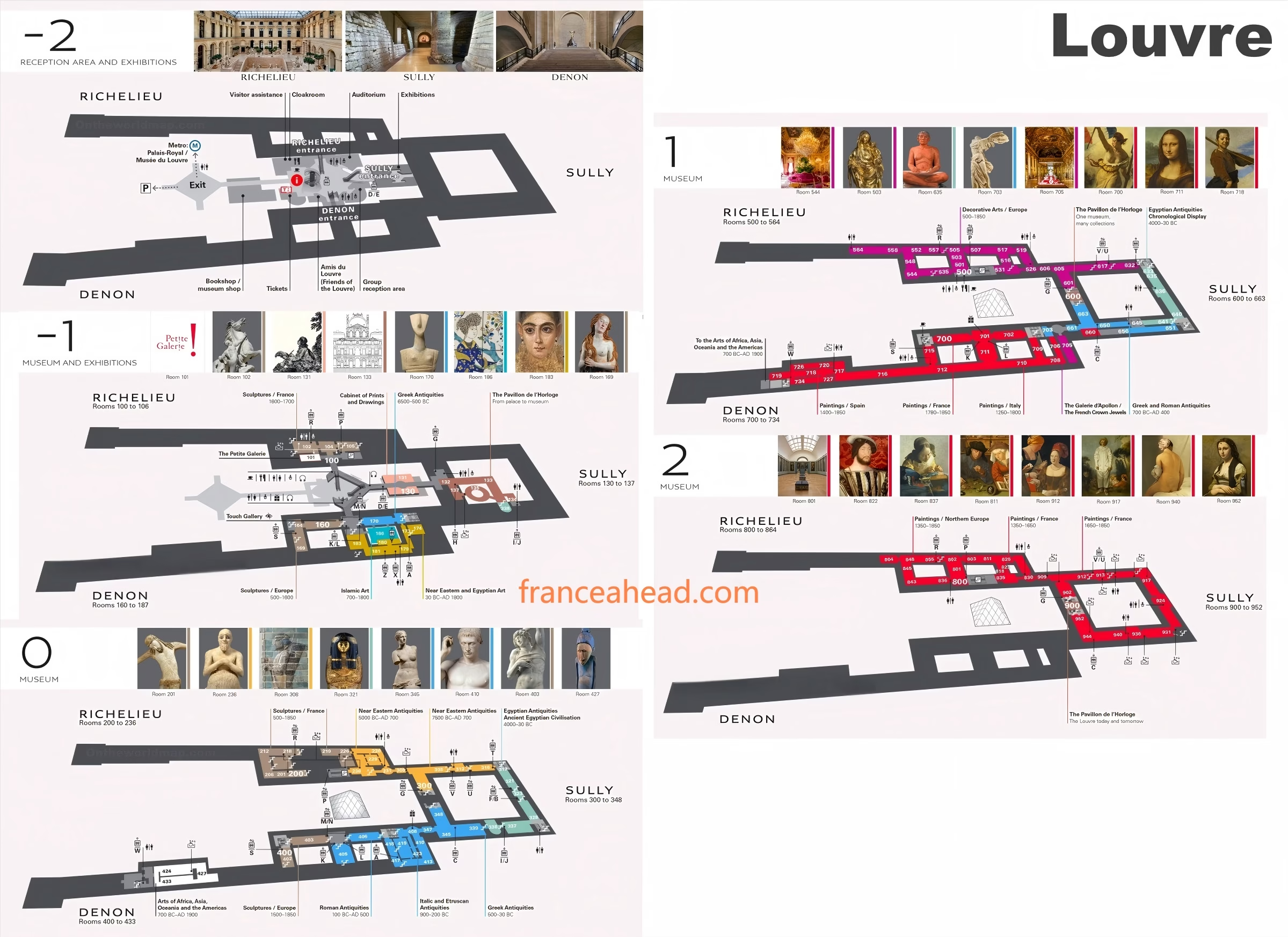
The Mona Lisa (La Joconde) by Leonardo da Vinci

Location: Denon Wing, Room 711
Let’s begin with the undisputed queen of the Louvre, the Mona Lisa. Located in the Denon Wing, this 16th-century masterpiece is undeniably the most famous painting in the world. Painted by Leonardo da Vinci between 1503 and 1506, the portrait of Lisa Gherardini del Giocondo—often referred to as “La Joconde” in French – draws millions annually. What’s remarkable is not just her enigmatic smile but also the technique: Da Vinci employed sfumato, a method of blending colors and tones, which makes the smile appear to change depending on where you stand. Measuring just 30 x 21 inches (77 x 53 cm), its small size belies its global influence. The glass and bulletproof case surrounding it may feel like a barrier, but that’s only because of the painting’s incredible value and significance. The subtle transitions in light on Mona Lisa’s face and hands will draw you in for hours, leaving you with the eternal question: What is she thinking?
The Venus de Milo

Location: Sully Wing, Room 345
The Venus de Milo, celebrated as one of the best examples of Hellenistic Greek sculpture, resides in the Sully Wing. The ancient Greek statue, dating back to around 150-125 BCE, is attributed to the artist Alexandros of Antioch. Though her arms are missing (likely from centuries of wear and tear), her allure hasn’t waned. Standing at 6 feet 8 inches (2 meters), Venus, the goddess of love, exudes graceful symmetry and refined beauty, making her the epitome of classical elegance. Her missing arms add to the mystique, with theories suggesting she might have once held an apple or a shield. Legend even proposes that she was discovered by a farmer on the island of Milos in 1820, her broken limbs buried beneath the soil. Whether or not you believe in her divine charm, you’ll find yourself marveling at how she’s captured the essence of timeless grace.
The Winged Victory of Samothrace

Location: Denon Wing, Room 703
As you ascend the grand staircase in the Denon Wing, prepare to be awestruck by the Winged Victory of Samothrace. This ancient Greek masterpiece was discovered on the island of Samothrace in 1863 and is believed to date back to 190 BCE. Standing nearly 8 feet tall (2.44 meters), the sculpture is an imposing figure, with Nike (the goddess of victory) triumphantly striding forward, her wings fully extended. The way her robe appears to billow with movement gives the impression that she’s swooped down from the heavens. Whether you’re looking at her from the front or behind, it feels as if she’s rushing towards you. This piece represents a monumental victory, possibly celebrating a naval battle, and it exudes more energy than most modern sculptures.
The Coronation of Napoleon by Jacques-Louis David

Location: Denon Wing, Room 702
As you step into the Denon Wing, you’ll be greeted by Jacques-Louis David’s grand “Coronation of Napoleon”. At 20 feet (6 meters) wide, this immense painting captures the self-assured Emperor Napoleon crowing his wife, Josephine, at Notre-Dame Cathedral in 1804. David’s meticulous attention to detail and vibrant colors bring Napoleon’s ambition to life, especially the dramatic focal point—Napoleon’s own crown, which he places on his head rather than waiting for the Pope. Napoleon’s dynamic presence is contrasted with the grandeur of the cathedral and the sweeping movements of the guests, who seem frozen in time, creating an unparalleled atmosphere of solemnity and power. The way David crafts this moment of supreme self-glorification is not only a historical depiction but also a work of pure political theatre.
The Code of Hammurabi

Location: Richelieu Wing, Room 3
You might not expect a stone stele to command your attention, but the Code of Hammurabi, located in the Richelieu Wing, demands it. This 4,000-year-old Babylonian artifact is a milestone in legal history, as it represents one of the world’s earliest written legal codes. Standing 7.4 feet (2.25 meters) tall, the stele is covered with 282 laws, carved into black basalt. On the upper portion, King Hammurabi is depicted receiving the laws from Shamash, the sun god and god of justice, whose hand extends towards the king in a divine gesture. The stele’s inscriptions highlight the sophisticated legal system of Babylon, detailing everything from family matters to contracts. Think of it as the world’s first “terms and conditions” agreement – but with the divine seal of approva
The Galerie d’Apollon

Location: Denon Wing, Room 349
The Galerie d’Apollon, located in the Denon Wing, is nothing short of dazzling. This Baroque-style gallery is an architectural and artistic marvel, designed by Louis Le Vau and Charles Le Brun to house the French crown jewels. Though the jewels have been relocated, the room’s ornate ceiling frescoes, painted by Le Brun, still depict Apollo, the sun god, surrounded by other figures from Greek mythology. The gold-leaf accents, the intricate stucco work, and the massive windows flood the space with light, creating a sense of divine royalty. Standing here feels like walking through the gates of Olympus, with each corner exuding sophistication and majesty. Take a moment to admire the playful interplay of light, sculpture, and painting that transforms the room into a living masterpiece.
The Egyptian Antiquities Collection
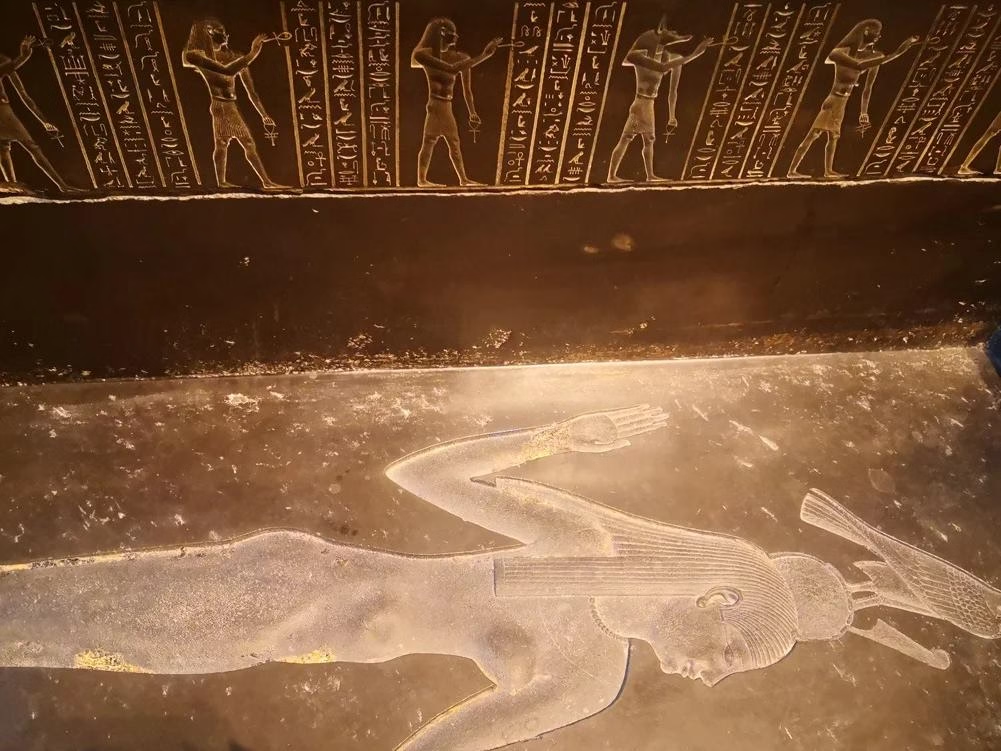
Location: Sully Wing, Rooms 300-344
If you’re fascinated by ancient Egypt, then the Egyptian Antiquities Collection is a must-visit. Spread across over 40 rooms, this collection offers more than 50,000 objects from one of the world’s oldest civilizations. From the tomb of the Egyptian priest to a stunning array of sarcophagi and mummies, this collection is packed with both mystery and beauty. One of the standout pieces is the Seated Scribe, a life-like sculpture of a middle-aged man with a calm expression and bright eyes, dating from around 2400 BCE. Also, don’t miss the Mummy of a Priest, which is so well-preserved that you’ll almost expect him to sit up and speak to you. Every item has a story to tell, and the collection offers an immersive experience that brings the grandeur of Egypt to Paris.
The Lacemaker by Johannes Vermeer

Location: Richelieu Wing, Room 836
Johannes Vermeer’s The Lacemaker is a quiet masterpiece that showcases his unrivaled ability to capture the most delicate moments of everyday life. Created around 1669-1670, the painting portrays a young woman sitting at a table, absorbed in her work of lace-making. The simplicity of the scene is what makes it so extraordinary. Standing just 9.5 x 7.9 inches (24 x 20 cm), the painting is a tiny marvel. Vermeer’s use of light here is particularly striking, illuminating the soft folds of the woman’s clothing and the fine lace in her hands, creating an almost ethereal glow. This intimate piece invites you to pause, reflect, and appreciate the beauty of simple acts – a quiet moment that reveals much about Vermeer’s mastery of light and perspective.
The Galerie des Antiques

Location: Richelieu Wing, Rooms 701-710
Step into the Galerie des Antiques, and you’ll feel as though you’ve entered an ancient Greek and Roman world. Spanning rooms 701-710 in the Richelieu Wing, this section houses over 250 sculptures and artifacts, with highlights like Laocoön and His Sons, an evocative Greek marble sculpture depicting the tragic fate of a Trojan priest and his sons, and the Apollo Belvedere, one of the finest examples of Greek classical idealism. The atmosphere is one of reverence, and as you walk through, you’ll be struck by the detail and craftsmanship of these ancient pieces, which have been preserved for centuries.
The Napoleon III Apartments
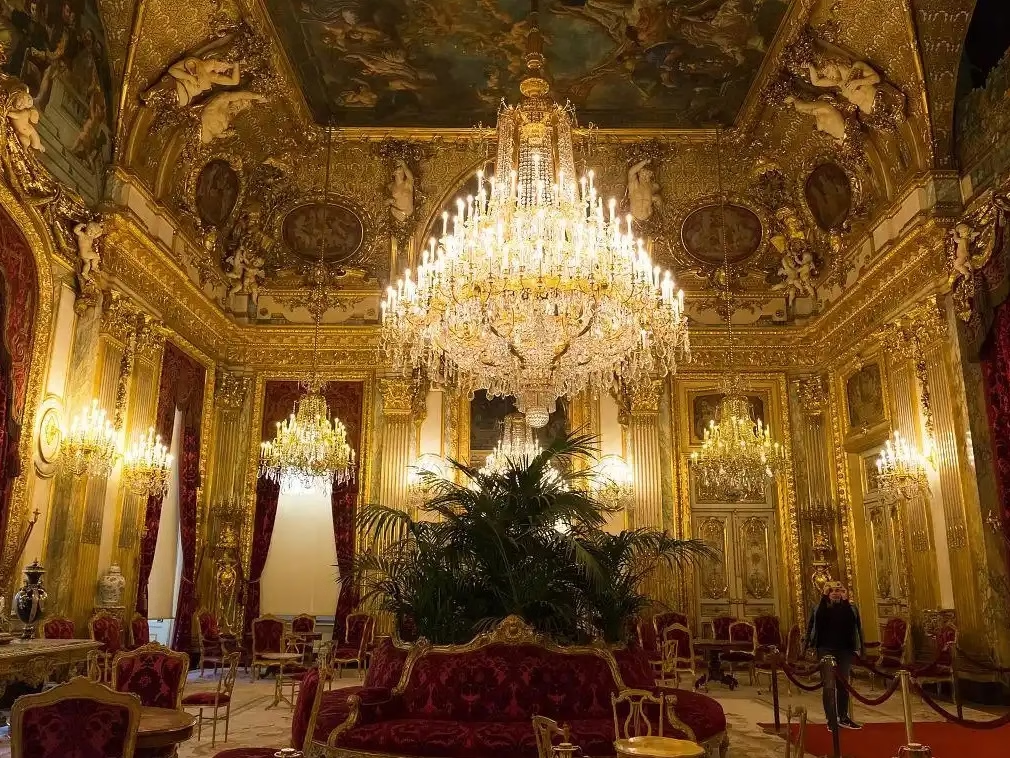
Location: Richelieu Wing, Rooms 544-552
The Napoleon III Apartments, located in the Richelieu Wing, offer a fascinating glimpse into the opulent lifestyle of the Second Empire. With 19th-century furnishings and grand chandeliers, these rooms, which were used by Emperor Napoleon III and his family, showcase the luxury of their time. The parquet floors, velvet curtains, and ornate furniture evoke a sense of high society, while the walls are adorned with rich tapestries and intricate wallpaper. It’s like stepping into a time capsule of French aristocracy, where every corner is filled with indulgence and taste. These rooms transport you to an era of imperial splendor and give you an intimate understanding of the lavish life led by one of France’s most famous rulers.
Best Time to Visit Louvre Museum
Best Time of Year
Off-Peak Season (January to March): So, winter in Paris might make you think of scarves, hot chocolate, and maybe a few snowflakes (if you’re lucky). But here’s the thing: winter is golden for the Louvre. The crowds? Practically nonexistent. You can walk around and actually enjoy the art without feeling like you’re in a sardine can. It’s quiet, cozy, and, yes, the art’s still the star of the show. You can finally get a proper look at that Mona Lisa without wondering if the guy next to you is really taking 42 selfies.
Shoulder Season (April to June, September to November): Here’s your “Goldilocks” time – just right. The weather is mild, and the crowds are definitely lighter than in summer. Imagine strolling through the Louvre, with Tuileries Garden just outside looking all lush and springy (or crisp in the fall). You can take in art and then take a leisurely walk in the park. It’s like the Louvre and Paris are giving you a big ol’ hug.
High Season (July to August): Ah, summer. The weather’s perfect, and so are the tourists – for the Louvre, anyway. You’ll have the whole world at your feet, or rather, in front of the Mona Lisa. It’s the most popular time to visit, and the museum is packed. You’ll get your steps in as you dodge crowds and selfie sticks. But if you’ve got a lot of patience (and maybe some good sunglasses to shield you from the throngs), it’s still doable. Just don’t expect to get close to any art without playing a bit of a game of “who’s elbowing who.” But hey, it’s summer in Paris – embrace the madness!
Best Time of Day
Morning (First Hour After Opening): If you’re an early riser (or at least willing to set the alarm early), this is gold. The Louvre opens at 9:00 AM, and the first hour or so is heaven. You get to actually see the art before the crowds pour in, which means you can stand in front of the Mona Lisa without anyone else trying to push you out of the way for the perfect shot. It’s like the museum is all yours for that sweet, quiet time. I mean, who doesn’t love a good “first one in, first to the paintings” moment?
Late Afternoon (Around 4:00 PM to 6:00 PM): Okay, so mornings aren’t your jam, but you still want to avoid the lunch-hour crush. Then the late afternoon is perfect. The crowds start thinning out, and you’ve still got a couple of hours to soak up the art. You won’t feel like you’re competing for a good spot in front of Winged Victory or Venus de Milo, and you might even get some cool lighting as the museum starts to quiet down. Just remember, the Louvre closes at 6:00 PM, so pace yourself – no rushing through the galleries, alright?
Evening (Wednesdays and Fridays – 6:00 PM to 9:00 PM): If you like to live life a little more on the wild side, try the evening hours on Wednesdays and Fridays. The Louvre stays open until 9:00 PM on these days, and it’s so much calmer in the evening. You get to experience the museum in a whole different vibe – fewer crowds, the lighting’s a little more dramatic, and you might even find you’re able to sneak in a few extra hours of wandering. Pro tip: If you’ve ever wanted to feel like an art connoisseur strolling through a museum after hours, this is your moment.
A Brief History of Louvre Museum
The Louvre – it’s not just a museum, it’s a journey through history itself. You’re in for a treat! It’s actually the oldest museum in the world in a way, though it didn’t start out that way. It began life in 1190 as a fortress built by King Philip II to protect Paris from invaders – hard to imagine that now, right? If you look carefully at the architecture, especially in the basement, you can still see remnants of those medieval walls.
Fast forward a few centuries, and King Francis I, who was a major art lover, decided to turn the place into a royal residence. That’s when the Louvre started to feel like the palace we now associate it with. But, it wasn’t until after the French Revolution in 1793 that the Louvre became the museum we recognize today. The revolutionaries had the brilliant idea of turning it into a public museum, with all the royal treasures on display for everyone. That was when it first opened its doors to the public – and I have to say, the art world’s been better for it ever since.
Then came the Napoleonic era, and that’s when the Louvre grew in both size and collection. Napoleon loved to conquer art, bringing back pieces from all over Europe. Some of these masterpieces were later returned, but the museum still holds an incredible array of artwork from that period.
As for its modern identity, the museum really made waves with the introduction of that stunning Glass Pyramid in 1989. Designed by architect I. M. Pei, the pyramid is iconic. It’s this perfect mix of ancient and modern – just like the museum itself. Today, the Louvre houses over 35,000 works of art, from the dawn of civilization all the way to the 19th century. You could spend days there and still not see everything!
Seven Fun Facts about Louvre Museum
It’s Huge – Like, Really Huge: The Louvre is so big that if you wanted to see everything in one day, you’d have to spend approximately 10 hours a day there for about three months! The museum spans 60,000 square meters of space. It’s so massive that a “day trip” could easily become an entire week’s worth of sightseeing if you want to see all the exhibitions.
The Mona Lisa’s Secret: The Mona Lisa, arguably the most famous painting in the world, has quite the backstory. Not only has it survived theft (it was stolen in 1911 and recovered two years later), but it also has an air of mystery—some people even claim that the painting changes its expression depending on where you stand! If you’re lucky, you might be one of those who sees it “smiling” at you.
The Glass Pyramid: The iconic glass pyramid in the courtyard wasn’t always part of the Louvre. When it was built in 1989, there was quite a bit of backlash against the modern structure in such a historic place. People thought it clashed with the museum’s classical architecture, but today, it’s one of the world’s most recognizable landmarks. If you want to get even nerdier: it has 35 glass panes on each side, and 35 is the perfect number for its geometric design!
The Louvre’s Name Has an Interesting Origin: The name “Louvre” actually comes from the French word “loup”, meaning “wolf.” Back in medieval times, the area where the Louvre now stands was a royal hunting ground, and the term might have originally referred to a “wolf trap” or a place where wolves were kept. So, the next time you’re admiring the art, remember you’re standing in what used to be a royal hunting preserve!
It Houses the World’s Oldest Known Piece of Art: The Louvre is home to the Venus de Milo, one of the most famous sculptures in the world, but did you know that it also holds the world’s oldest known piece of art? That would be the “The Cave of Lascaux” paintings, estimated to be over 17,000 years old. These prehistoric paintings, located in the museum’s Paleolithic collection, offer a glimpse into the world’s earliest human creativity.
A Secret Tunnel Runs Beneath It: Beneath the Louvre, there’s a secret passageway that connects the museum to the Tuileries Gardens and even to the nearby Palais Royal. This underground tunnel was used by French royalty in the past, especially Napoleon Bonaparte, who was known to use it for his secretive movements across the city. The tunnel is not open to the public, but its existence adds another layer of intrigue to the history of the Louvre!
It Was a Safe Haven During WWII: During World War II, the Louvre became a fortress of art preservation. With Nazi occupation looming, the museum’s priceless works were evacuated to safe locations across France to prevent theft. The Mona Lisa, for example, was secretly sent to a castle in the French countryside. The Louvre’s staff went to incredible lengths to ensure the art’s safety during such turbulent times.
Dining Options Within Louvre Museum
1. Café Richelieu – Angelina
- Location: Richelieu Wing, inside the museum, on the first floor.
- Average Cost: €15-€30 per person.
- Menu: Famous for its French pastries and refined atmosphere, Café Richelieu – Angelina is a fantastic option if you’re craving something indulgent. It offers a range of savory options, including salads, sandwiches, and quiches. However, the real star of the menu is their dessert selection. Don’t miss their iconic Mont-Blanc pastry, a meringue, whipped cream, and chestnut purée dessert.
2. Le Café Mollien
- Location: Mollien Wing, on the first floor, near the Grand Gallery.
- Average Cost: €15-€25 per person.
- Menu: Le Café Mollien is a relaxed dining spot offering a selection of French bistro-style dishes. You’ll find quiches, salads, sandwiches, and hearty soups, all made with fresh, seasonal ingredients.
3. Le Café Marly
- Location: Richelieu Wing, overlooking the Cour Napoléon and the Glass Pyramid.
- Average Cost: €20-€40 per person.
- Menu: Le Café Marly is an upscale restaurant offering a more refined dining experience. The menu features a variety of French bistro classics, including dishes like duck confit, fish of the day, and gourmet salads. You can also enjoy a fine selection of wines and desserts. The café’s elegant décor and spectacular views of the Louvre courtyard and pyramid make it a memorable place for a more luxurious lunch or dinner.
4. The Carrousel du Louvre Mall
- Location: Underground, within the Carrousel du Louvre shopping mall, just beneath the museum.
- Average Cost: €10-€25 per person.
- Menu: While not inside the museum itself, the Carrousel du Louvre shopping area offers additional dining options. The food court has a variety of international fast-food outlets, including French creperies, Italian pizza parlors, and burger joints. This is a great spot if you’re looking for a more casual and affordable meal, particularly if you’re traveling with children.
Six Attractions Near Louvre Museum to Entrich Your Tour
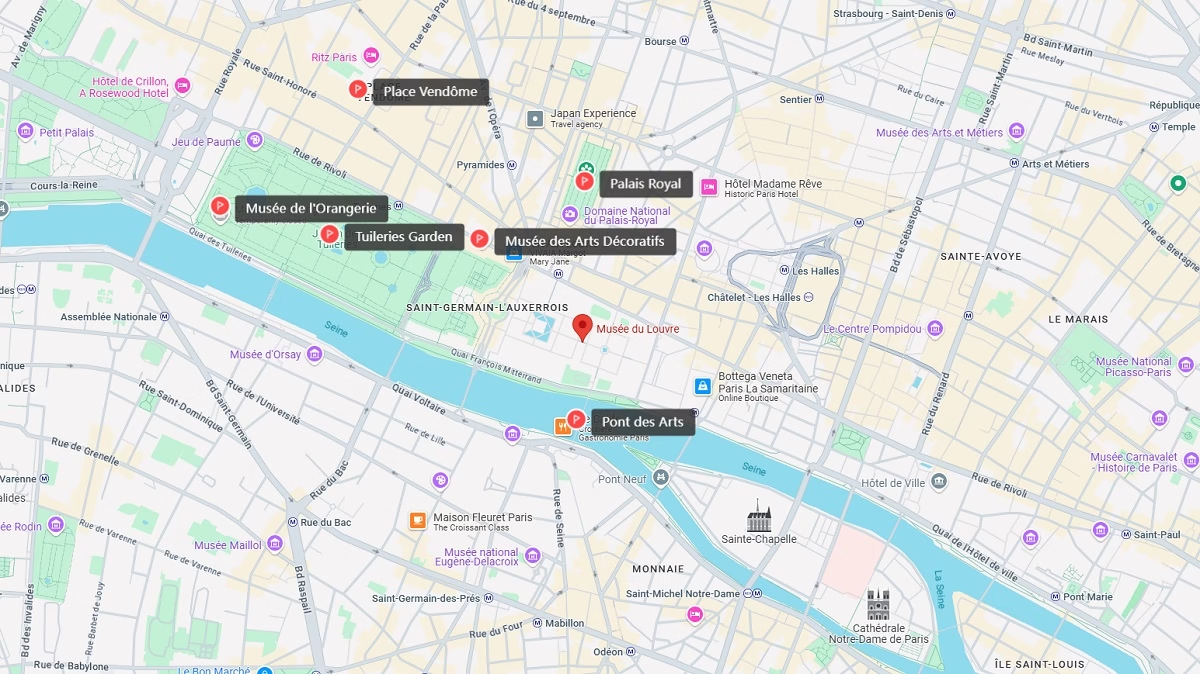
Tuileries Garden (Jardin des Tuileries)

- Distance: 2 minutes’ walk (0.2 km) from the Louvre
- Opening Hours: 7:00 AM – 9:00 PM
- Ticket Price: Free entry
- Highlights: The Tuileries Garden, designed by the famous landscape architect André Le Nôtre in the 17th century, is one of the most beautiful and historic public gardens in Paris. It’s perfect for a relaxing stroll with its manicured lawns, fountains, and statues. The Grand Bassin and Orangerie are notable spots within the gardens. You can also visit the Tuileries Carousel, which is an old, charming carousel dating back to 1800.
Musée de l’Orangerie

- Distance: 7 minutes’ walk (0.6 km) from the Louvre
- Opening Hours: Monday to Sunday: 9:00 AM – 6:00 PM; Closed on Tuesdays.
- Ticket Price: €12
- Highlights: The Musée de l’Orangerie is home to some of the finest collections of Impressionist and Post-Impressionist art, with works from Claude Monet, Paul Cézanne, Henri Matisse, and Amedeo Modigliani. The museum is best known for Monet’s monumental Water Lilies murals, which fill two oval rooms, providing a peaceful, immersive experience.
Palais Royal

- Distance: 5 minutes’ walk (0.4 km) from the Louvre
- Opening Hours: Open daily, 24 hours for the gardens, but most stores and restaurants close by 7:00 PM.
- Ticket Price: Free for the gardens. For exhibitions or performances in the Palais Royal, prices vary.
- Highlights: The Palais Royal is a stunning historic building with beautiful gardens, arcades, and galleries. Originally the residence of Cardinal Richelieu, it later became the home of the French royal family. The Colonnade and Les Deux Plateaux (a modern art installation by Daniel Buren) are a must-see.
Musée des Arts Décoratifs
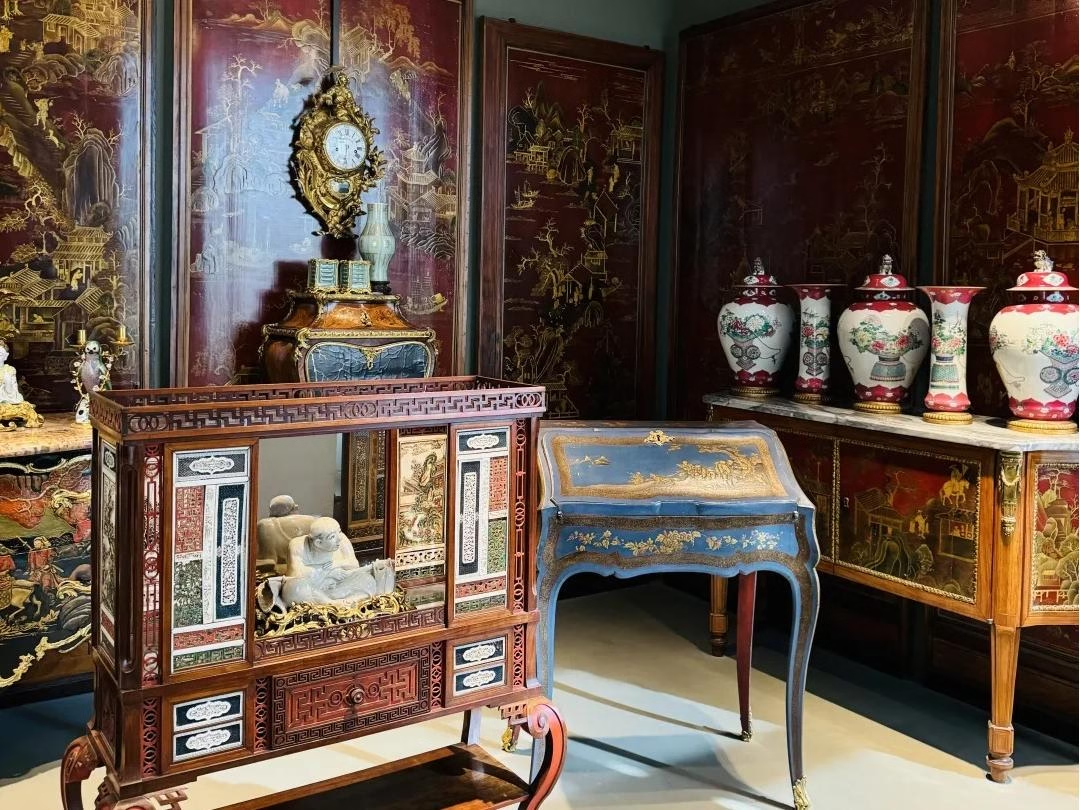
- Distance: 5 minutes’ walk (0.4 km) from the Louvre
- Opening Hours: Tuesday to Sunday: 11:00 AM – 6:00 PM; Closed on Mondays.
- Ticket Price: €14
- Highlights: The Musée des Arts Décoratifs is dedicated to showcasing decorative arts, from furniture to fashion to jewelry. Its collections cover over 500 years of French craftsmanship and include works by Rene Lalique, Christian Dior, and more. One of its main attractions is the Fashion and Textile collections, which include clothing from the 18th century to the modern era.
Pont des Arts (Bridge of Arts)

- Distance: 6 minutes’ walk (0.5 km) from the Louvre
- Opening Hours: Always open, as it’s an outdoor pedestrian bridge
- Ticket Price: Free
- Highlights: The Pont des Arts is a charming pedestrian bridge that spans the Seine River, connecting the Louvre to the Institut de France. It’s famous for its “love locks,” though many have been removed for safety reasons. It’s the perfect spot for a photo with the Louvre and the Île de la Cité in the background.
Place Vendôme
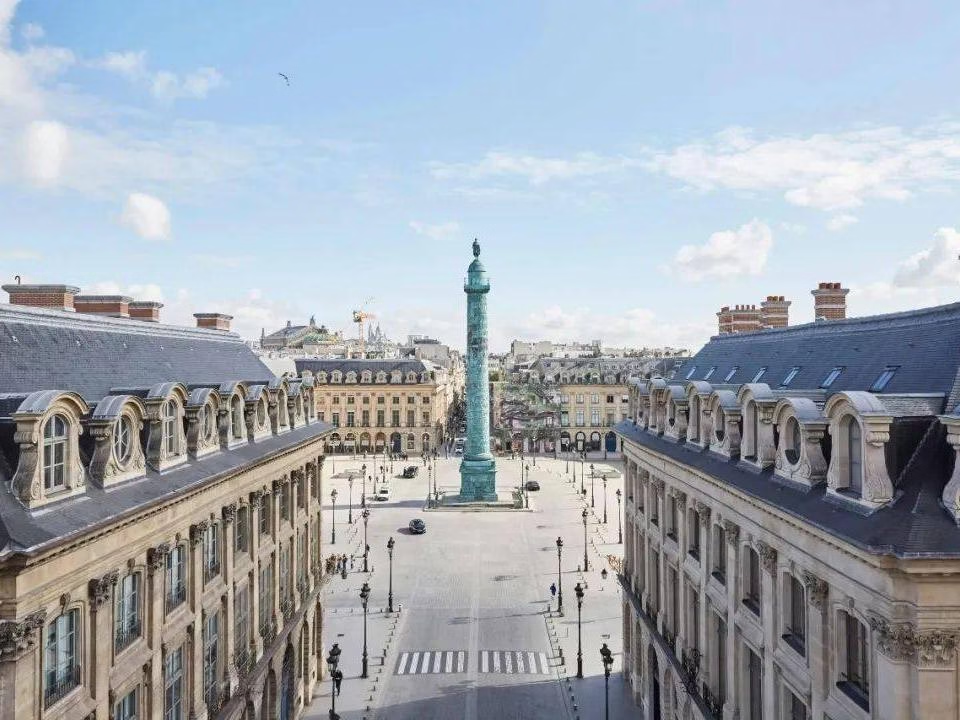
- Distance: 7 minutes’ walk (0.6 km) from the Louvre
- Opening Hours: Always open
- Ticket Price: Free
- Highlights: The Place Vendôme is one of Paris’s most elegant squares, famous for its opulent shops, especially luxury jewelry stores like Chanel, Bvlgari, and Cartier. The square is dominated by the Vendôme Column, which commemorates Napoleon’s victory at the Battle of Austerlitz. This area is perfect for those wanting to experience Parisian luxury.
Top 5 Affordable Hotels Near Louvre Museum

1. Hotel Britannique
- Distance to Louvre Museum: 10-minute walk (approximately 800 meters)
- Average Price per Room: €150–€250 per night
- Address: 20 Avenue Victoria, 75001 Paris, France
- Features: A charming 3-star hotel located in a quiet yet central area, Hotel Britannique offers a cozy atmosphere and convenient access to the Louvre.
2. Hôtel Louvre Richelieu
- Distance to Louvre Museum: 5-minute walk (approximately 400 meters)
- Average Price per Room: €120–€180 per night
- Address: 9 Rue du Roule, 75001 Paris, France
- Features: Hôtel Louvre Richelieu is a budget-friendly 3-star hotel situated just a short walk from the Louvre Museum. The rooms are simple, clean, and well-maintained, offering essential amenities.
3. Hotel du Continent
- Distance to Louvre Museum: 8-minute walk (approximately 650 meters)
- Average Price per Room: €160–€230 per night
- Address: 30 Rue du Mont Thabor, 75001 Paris, France
- Features: Located in a quaint and quiet area near the Louvre, Hotel du Continent is a small but lovely 3-star hotel offering rooms with unique and colorful décor.
4. Hotel Le Relais Saint-Honoré
- Distance to Louvre Museum: 6-minute walk (approximately 500 meters)
- Average Price per Room: €190–€280 per night
- Address: 308 Rue Saint-Honoré, 75001 Paris, France
- Features: A charming boutique hotel, Hotel Le Relais Saint-Honoré offers a cozy and intimate atmosphere with a great location near the Louvre.
5. La Clef Louvre Paris
- Distance to Louvre Museum: 5-minute walk (approximately 400 meters)
- Average Price per Room: €250–€500 per night
- Address: 8 Rue de Richelieu, 75001 Paris, France
- Features: La Clef Louvre Paris is an upscale 5-star hotel offering stylish, apartment-style rooms with kitchens, making it an excellent choice for guests who want to stay for a longer period. Guests appreciate its spacious suites, complimentary Wi-Fi, fitness center, and concierge service.

